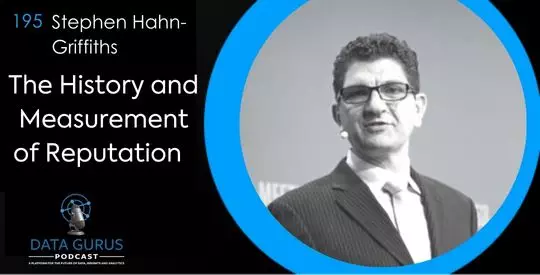Podcast: Play in new window | Download
Today, Stephen Hahn-Griffiths, the Global Executive Vice President of Enterprise Growth for the RepTrak Company, joins Sima to discuss the history and measurement of reputation. They dive into what reputation is, what shapes it, how to measure it, and its consequences.
Stephen’s background
Stephen was born and raised in the UK, and he has been living in the US since the end of the 1990s. He trained in science for many years and geared himself toward becoming a doctor. But just before he was about to go to medical school, he changed his mind for personal reasons and moved into the realm of branding and reputation.
He spent his formative years in the agency world. He joined the RepTrak Company eight years ago. He applies many of the skills he used in the agency world to what he does now at RepTrak.
Stephen’s current focus
Stephen currently focuses on the premise of reputation, what it is, what drives it, and how it can help elevate the success trajectory of companies.
Reputation
The concept of reputation, how to measure it, harness it, and capture it as a tangible life force, is only about 25 years old. However, conversations about branding have been happening for around a hundred years.
The first written evidence of reputation
The first written evidence of what is now known as reputation existed about 4,000 years ago, in ancient China.
The definition of reputation
A reputation exists in the eye of the beholder. Your reputation is how people perceive you. That gets informed by everything you do and say.
Something interesting about reputation
Something interesting about reputation is that it ultimately drives behavior. It lies at the heart of the decision-making process when people compare one company with another.
Brand versus reputation
Your brand is the promise you intend to keep, whereas your reputation is your assessment of whether or not that promise has been fulfilled.
A disconnect
A disconnect happens when a company has a high-powered brand story but falls short of people’s expectations. That results in a decline in reputation.
Three simple parts
Reputation can be broken down into three simple parts:
- How you feel
- Creating a rational foundation for your emotional belief
- How you feel and what you think drives your intended behavior
Products and services
For most companies, products and services are typically the most important driver of their reputation.
Conduct and citizenship
A company’s conduct and citizenship often become the second most important driver of its reputation.
Reputation can be an inhibitor or accelerator
A physicist connected the dots and created a measurable outcome to help people understand and appreciate that reputation can either be an inhibitor or an accelerator for a business.
A trigger point
Whether they decide to do something about it or not, all companies care about their reputations because they understand that reputation is a trigger point for their accelerated success.
Fortune companies
Fortune companies tend to fixate on their reputations because the stakes and consequences are much higher.
Why reputation counts
A company’s reputation counts because people are looking to support and work for companies that operate fairly and make a concerted effort to make this world a better place to live.
Reputation has become a full-contact sport
Power has shifted from corporate and corporate brands to consumers. Stephen feels that that power shift has turned reputation into a full-contact sport because all companies are just one negative Tweet away from a potential crisis. So they now have to constantly focus on managing their reputations.
Balancing purpose with profits
Companies that balance being purposeful in the way they operate with being profitable tend to do much better in terms of their reputations.
The future of reputation management
Stephen believes that unofficial intelligence has a critical role in the future of reputation management.
Links:
Email me your thoughts
Sima@Infinity-2.com




